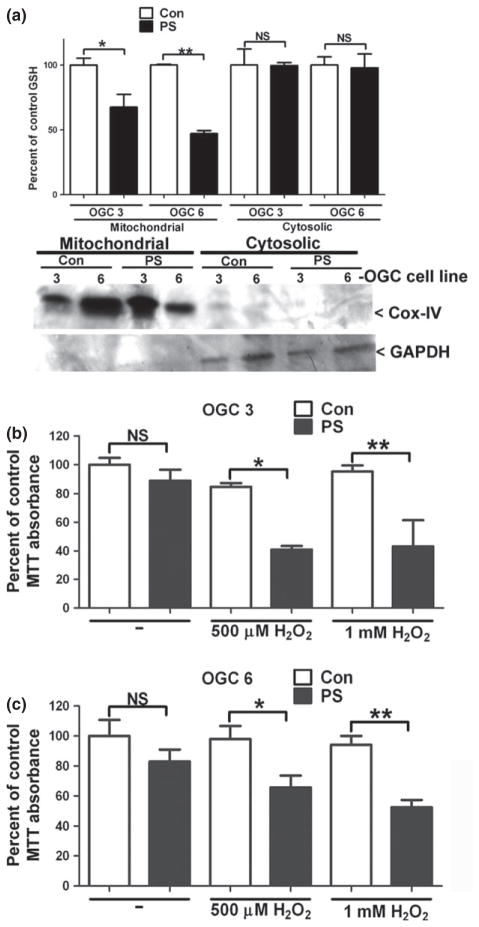Fig. 4.
Chemical inhibition of OGC transport function specifically reduces mitochondrial glutathione (GSH) and resensitizes OGC stable cell lines to oxidative stress induced by hydrogen peroxide. (a) Stable OGC NSC34 cells were treated with 10 mM phenylsuccinate (PS) overnight. Cells were then fractionated using differential centrifugation. Cell fractions were measured for total GSH using a DTNB colorimetric assay. Data are represented as a percent of untreated control (Con) GSH. *p < 0.05 compared to OGC 3 Con **p < 0.01 versus OGC 6 Con; NS, not significant via a Student’s t-test. n = 4, error bars indicated SE. Cell fractions were resolved by sodium dodecyl sulfate–polyacrylamide gel electrophoresis (SDS–PAGE) and immunoblotted against cytochrome c oxidase or complex IV (Cox-IV) and glyceraldehyde 3-phosphate dehydrogenase (GAPDH). (b) Stable OGC 3 NSC34 cells were treated with 10 mM PS alone or in combination with 500 μM or 1 mM H2O2. At 24 h after treatment an 3-(4,5-dimethylthiazol-2-yl)-2,5-diphenyltetrazolium bromide (MTT) assay was completed and data are represented as percent of there presentative Con (i.e., the same treatment in the absence of PS). *p < 0.05, **p < 0.01 versus Con, NS, not significant; via a one-way ANOVA with post hoc Tukey’s test n = 3, error bars indicate SE. (c) Stable OGC 6 NSC34 cells were treated with 10 mM PS alone or in combination with 500 μM or 1 mMH2O2. At 24 h after treatment an MTT assay was completed and data are represented as percent of the representative control Con (i.e., the same treatment in the absence of PS). *p < 0.05, **p < 0.01 versus Con, NS, not significant; via a one-way ANOVA with post hoc Tukey’s test n = 5, error bars indicate SE.

